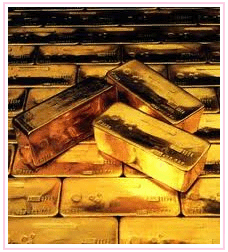Gold history

From the first discoveries of gold in ancient times, its beauty and the ease with which it could be worked inspired craftsmen to create it into ornaments, not just for adornment, but as symbols of wealth and power.
The skills of the goldsmith from ancient Egypt to Benvenuto Cellini or Carl Faberge still amaze us. As Pindar wrote nearly 2,500 years ago, "Gold is the child of Zeus, neither moth nor rust devoureth it".
Today, gold jewellery is more a mass- market product, although in many countries still treasured as a basic form of saving. jewellery fabrication is the crucial cornerstone of the gold market.
For the past several years, the brilliant luster of Gold has fascinated many. Since it was first found it has been a part of our lives. To a lot of people Gold has not just been a precious metal but an investment as well. Since the stone age as estimated 1,30,000 tones of gold has been produced, over half of which has been mined since 1850.
It may sound surprising but it is true that as many as 17 tones of ore is mined to extract a single ounce (31.104gm) of gold.
Gold is available from earth's crust, in the seas, river and plants. In nature gold if found in veins and secondary alluvial deposits as a free metal or in combined state.
Gold is also recovered as byproduct from Silver & Copper refining. Placer mining or panning and open pit mining is techniques commonly used to recover gold from earth. South Africa is world's single largest gold producer, followed by USA, Australia, Russia and Canada and West Africa.
Pure gold is used in those parts of the world where jewellery is purchased as much for in- vestment as it is for adornment, but it tends to be vulnerable to scratching. Elsewhere, it is usually mixed, or alloyed, with other metals.
Not only do they harden it, but influence the colour; white shades are achieved by alloying gold with silver, nickel
1.What is Gold and why is its chemical symbol Au?
Gold is a rare metallic element with a melting point of 1064 degrees centigrade and a boiling point of 2808 degrees centigrade. Its chemical symbol, Au, is short for the Latin word for gold, 'Aurum', which literally means 'Glowing Dawn'. It has several properties that have made it very useful to mankind over the years, notably its excellent conductive properties and its inability to react with water or oxygen.2. Why is gold measured in carats?
This stems back to ancient times in the Mediterranean /Middle East, when a carat became used as a measure of the purity of gold alloys (see next Question 5). The purity of gold is now measured also in terms if fineness, i.e parts per thousand. Thus 18 carats is 18/24th of 1000 parts = 750 fineness.3. What is a Carat?
A Carat (Karat in USA & Germany) was originally a unit of mass (weight) based on the Carob seed or bean used by ancient merchants in the Middle East. The Carob seed is from the Carob or locust bean tree. The carat is still used as such for the weight of gem stones (1 carat is about 200 mg). For gold, it has come to be used for measuring the purity of gold where pure gold is defined as 24 carats.How and when this change occurred is not clear. It does involve the Romans who also used the name Siliqua Graeca (Keration in Greek, Qirat in Arabic, now Carat in modern times) for the bean of the Carob tree. The Romans also used the name Siliqua for a small silver coin which was one-twentyfourth of the golden solidus of Constantine. This latter had a mass of about 4.54 grams, so the Siliqua was approximately equivalent in value to the mass of 1 Keration or Siliqua Graeca of gold, i.e the value of 1/24th of a Solidus is about 1 Keration of gold, i.e 1 carat.
4. How much new gold is produced per year?
In 2001, mine production amounted to 2,604 tonnes, or 67% of total gold demand in that year. Gold production has been growing for years, but the real acceleration took place after the late 1970s, when output was in the region of 1,500tpa. This year’s output will fall short of production levels in 2001. This is partly for specific operational reasons at some of the larger mines (Grasberg and Porgera), along with lower grades at some of the operations in Nevada. The reduction in exploration and development expenditure over the past five years is leading a number of analysts to suggest that, with other operations nearing the end of their lives, global production is likely to drop slightly over the next two to three years – subject always of course to price.5. How much does it cost to run a gold mine?
Gold mining is very capital intensive, particularly in the deep mines of South Africa where mining is carried out at depths of 3000 meters and proposals to mine even deeper at 4,500 meters are being pursued. Typical mining costs are US $238/troy ounce gold average but these can vary widely depending on mining type and ore quality. Richer ores mined at the surface (open cast mining) is considerably cheaper to mine than underground mining at depth. Such mining requires expensive sinking of shafts deep into the ground.6. How much gold is there in the world?
At the end of 2001, it is estimated that all the gold ever mined amounts to about 145,000 tons. .7. How does a gold mine work?
The gold-containing ore has to be dug from the surface or blasted from the rock face underground. This is then hauled to the surface and milled to release the gold. The gold is then separated from the rock (gangue) by techniques such as flotation, smelted to a gold-rich doré and cast into bars. These are then refined to gold bars by the Miller chlorination process to a purity of 99.5%. If higher purity is needed or platinum group metal contaminants are present, this gold is further refined by the Wohlwill electrlytic process to 99.9% purity. Mine tailings containing low amounts of gold may be treated with cyanide to dissolve the gold and this is then extracted by the carbon in pulp technique before smelting and refining.8. Alchemy: Can base metals be turned into gold?
All metal atoms are made of the same building blocks of protons, neutrons and electrons, but in different quantities, so in theory it could be possible to change base metals into gold or any other metal of value to mankind. In practice, it is achieved only in nuclear reactions, where heavy radioactive metals decay into other lighter elements, including some isotopes of gold. However, man's ancient dream of turning base metals into gold is not a practical proposition. So it remains a dream!9. How big is a tonne of gold?
Gold is traditionally weighed in Troy Ounces (31.1035 grams). With the density of gold at 19.32 g/cm3, a troy ounce of gold would have a volume of 1.64 cm3. A tonne of gold would therefore have a volume of 51, 760 cm3, which would be equivalent to a cube of side 37.27cm (Approx. 1' 3'').10.Where does the word Gold come from?
The word gold appears to be derived from the Indo-European root 'yellow', reflecting one of the most obvious properties of gold. This is reflected in the similarities of the word gold in various languages: Gold (English), Gold(German), Guld (Danish), Gulden (Dutch), Goud (Afrikaans), Gull (Norwegian) and Kulta (Finnish).11. Who owns the most gold?
If we take national gold reserves, then most gold is owned by the USA followed by Germany and the IMF. If we include jewellery ownership, then India is the largest repository of gold in terms of total gold within the national boundaries. In terms of personal ownership, it is not known who owns the most, but is possibly a member of a ruling royal family in the East.
